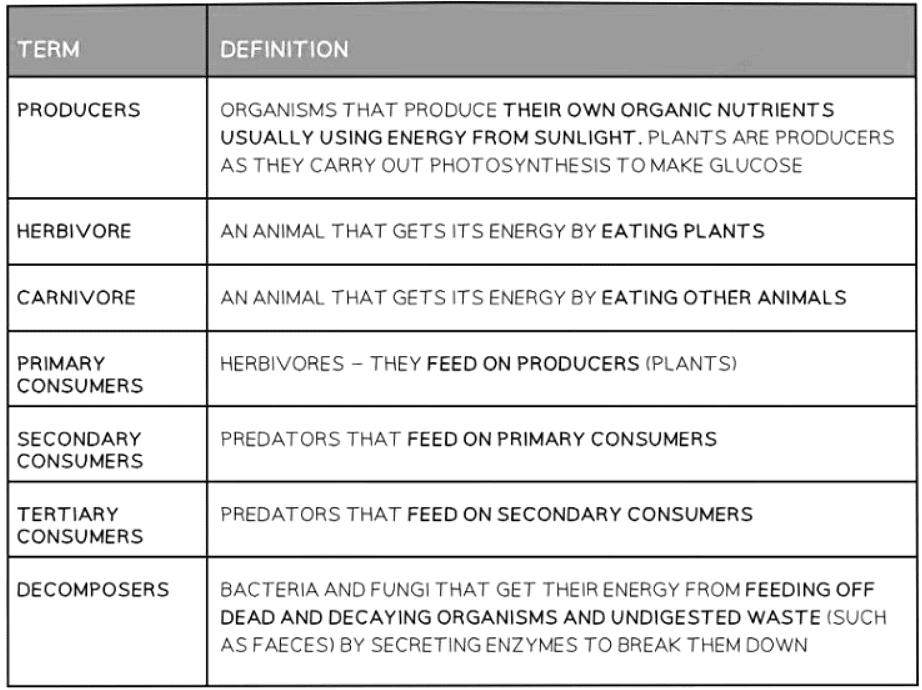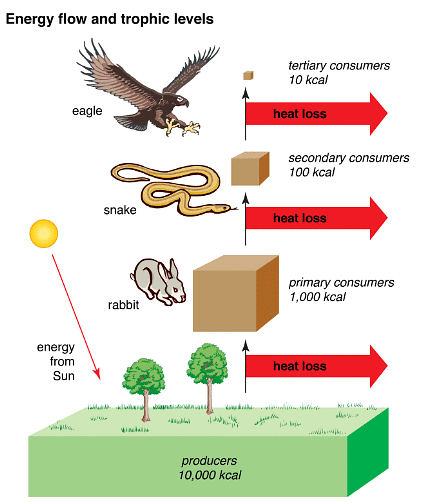Class 10 Exam > Class 10 Notes > Biology for GCSE/IGCSE > Food Chains & Food Webs
Food Chains & Food Webs | Biology for GCSE/IGCSE - Class 10 PDF Download
Food Chains


- A food chain demonstrates the transfer of energy from one organism to another, commencing with a producer.
- Light energy from the Sun serves as the fundamental energy source in a food chain.
- The directional arrows in a food chain exhibit the flow of energy from one trophic level to the next.
- Energy is conveyed from one organism to another through ingestion (consumption).
- In the depicted food chain:

Food Webs
- A food web, a complex network of interconnected food chains, represents a more realistic portrayal of how organisms in an ecosystem interact.
- Food webs illustrate the diverse connections between organisms, highlighting that animals seldom rely on a single food source.

The Significance of Food Webs
- Food webs exhibit the interdependence of organisms within an ecosystem, showcasing how various species rely on each other for sustenance.
- They offer valuable insights into energy transfer within ecosystems and demonstrate the concept of interdependence.
- For instance, a decrease in the earthworm population can trigger a cascade of effects:
- The dwindling earthworm population leads to an increase in grass plants, as fewer organisms feed on them.
- Frogs and mice, heavily reliant on earthworms as their primary food source, experience significant population declines.
- Sparrows, while mildly impacted due to their varied diet including caterpillars, also witness a slight decrease in population.
- Human activities, such as overharvesting or introducing alien species, can disrupt food webs, causing lasting repercussions across ecosystems.
- Most changes in animal and plant populations are a result of human activities: Human actions such as overharvesting food species or introducing non-native species can disrupt the natural balance of ecosystems, causing ripple effects throughout the food chain.
- Long-lasting consequences of human-induced changes on organisms in food chains: These alterations can have enduring impacts on various species within the ecosystem, potentially leading to imbalances that persist over extended periods.
Question for Food Chains & Food WebsTry yourself: How does a food chain demonstrate the transfer of energy?View Solution
The document Food Chains & Food Webs | Biology for GCSE/IGCSE - Class 10 is a part of the Class 10 Course Biology for GCSE/IGCSE.
All you need of Class 10 at this link: Class 10
|
101 videos|193 docs|33 tests
|
FAQs on Food Chains & Food Webs - Biology for GCSE/IGCSE - Class 10
| 1. What is the difference between food chains and food webs? |  |
Ans. Food chains show a linear sequence of organisms in an ecosystem, where each organism is eaten by the next one in line. Food webs, on the other hand, depict a network of interconnected food chains, showing the multiple pathways of energy flow in an ecosystem.
| 2. How do food chains and food webs help in understanding the flow of energy in an ecosystem? |  |
Ans. Food chains and food webs help in understanding the flow of energy in an ecosystem by showing how energy is transferred from one organism to another through consumption. They illustrate the relationships between different organisms and how energy moves through the ecosystem.
| 3. What role do producers, consumers, and decomposers play in food chains and food webs? |  |
Ans. Producers, such as plants, are the base of food chains and food webs as they convert sunlight into energy through photosynthesis. Consumers, including herbivores, carnivores, and omnivores, eat other organisms to obtain energy. Decomposers break down dead organic matter and recycle nutrients back into the ecosystem.
| 4. How can disruptions in food chains and food webs impact an ecosystem? |  |
Ans. Disruptions in food chains and food webs can lead to imbalances in the ecosystem. For example, if a predator population declines, it can result in an increase in the population of its prey, which may then overconsume other organisms and disrupt the balance of the ecosystem.
| 5. How are human activities affecting food chains and food webs in various ecosystems? |  |
Ans. Human activities such as deforestation, pollution, overfishing, and habitat destruction can disrupt food chains and food webs in various ecosystems. This can lead to a decline in biodiversity, the extinction of species, and overall ecosystem degradation.
Related Searches















